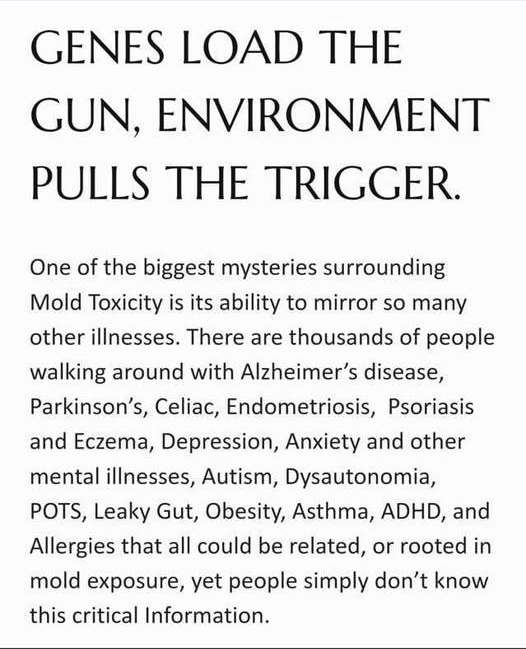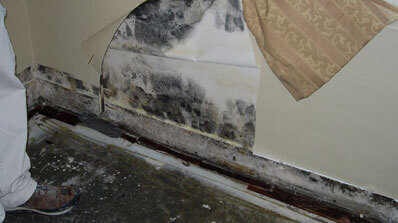Remote Life, More Air Testing, and More Toxic Buildings are Causational for Uptick in CIRS Patients
With so many working so hard to figure their health out combined with the increase in remote working lifestyle has caused us to have more time in our homes.
According to the EPA, 50% of buildings in the US classify as water damaged.
Whatever the cause in more CIRS diagnosis, it is a step towards healing and also accountability.
What are the Risks of Getting CIRS?
Dr. Shoemaker’s work in review of international gene registries, matched by case controlled studies, revealed that 24%, nearly 1 in 4 people in the population is “mold susceptible” due to their HLA haplotype.
Our environment we live in is part of it, but this also means our genetics play a role.
Meanwhile, exposure to water damaged buildings also increases the risk of developing a chronic biotoxin-related illness like CIRS.

CIRS Risk Is Part Genetic, Part Environmental
So, CIRS patients get dealt an awful health outcome due to genetics they cannot control, in a world where there is a 50% chance of living in a water damaged building.
Another fact adding to the CIRS diagnosis is that our genetic makeup plays a role, and the odds aren’t so good either.
In addition to your own odds, families of 2 or more people, all having different genetics can mean that one member of your family carries on the toxic load that others do not.
Beyond that, this means that 25% of Americans are putting their health at risk with Spring Cleaning or just going into the workplace where there might be mold or water damage.
“Dr. Shoemaker estimates that 80% of Chronic Inflammatory Response Syndrome (CIRS) cases are caused by repeated exposure to water-damaged buildings. These cases are designated as Chronic Inflammatory Response Syndrome (caused by) Water Damaged buildings or CIRS-WDB.” –Surviving Mold
What If the Building Is Making You Sick?
We’re at the tipping point of a medical and philosophical shift, where environmental exposures, like mold and water-damaged buildings, are being recognized as key factors in chronic illness.
Science is beginning to vertically integrate these environmental elements into our understanding of health.
“We’re in the middle of a medical revolution, where science is finally connecting the dots between chronic illness and environmental exposures. The culprits are hiding in plain sight.” -CIRS, Not Sick Building Syndrome
What is Sick Building Syndrome? (Outdated term)
Sick Building Syndrome (SBS) is many symptoms that occur from people spending time in buildings with toxic air or other contamination.
While the “cause” of SBS is uncertain, we are lucky to have the work of Dr. Shoemaker on CIRS, which although SBS is a diagnosis for buildings, it is complimentary as the label appropriate for the cause of CIRS or CIRS-WDB.

Why is CIRS related to Sick Building Syndrome (SBS)?
SBS terminology began to be used in the 1980s to describe the unknown, primarily issues resulting from a workplace concern connected to poor ventilation, off-gassing materials, and generalized symptoms of other occupants. Then at that time, It was more of an occupational health concept and used generally but not professionally.
CIRS label is for humans, SBS labeling is for the buildings with toxic air or other contamination impacting the health of humans.
More so, just like CIRS, the SBS labeled building can cause a range of symptoms, but they will get better when a person spends time away from the SBS building.
Hope For Healing with CIRS?
“Thirteen articles referenced treatment for CIRS, and 22 articles referenced treatment for CFS. The only treatment with documented clinical efficacy was the Shoemaker Protocol, which was described in 11 of the 13 articles. This treatment protocol exhibits superior outcomes compared with the treatment protocols for Myalgic Encephalomyelitis (ME) or Chronic Fatigue Syndrome (CFS).” –CIRS: A Review of the Evidence of Clinical Efficacy of Treatment
While much of western medicine is still not fully caught up to the scientific grounds for CIRS, those who are healing can be found using the Shoemaker Protocol.
Much of the diagnosis for Myalgic Encephalomyelitis or Chronic Fatigue Syndrome ends there and the healing is not coming from any researchers reports.
No cure for CFS and ME according to the Center for Disease Control, but we are seeing individualized medical doctors who are working with Shoemaker Protocols to heal CIRS patients.
Which proposes the question, just how different is CFS, ME and CIRS?
Considering they share some commonality and are often misdiagnosed, it is important to look at the potential of the Shoemaker Protocol helping many of these CFS and ME patients left with no hopes for healing.
As researchers and clinicians continue to explore these complex conditions, it may be worth investigating whether components of the Shoemaker Protocol could offer hope to some patients previously diagnosed with CFS or ME.
